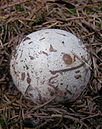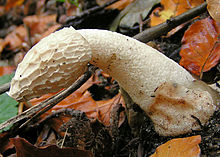Common stinkhorn
| Common stinkhorn | ||||||||||||
|---|---|---|---|---|---|---|---|---|---|---|---|---|

Common stinkhorn ( Phallus impudicus ) |
||||||||||||
| Systematics | ||||||||||||
|
||||||||||||
| Scientific name | ||||||||||||
| Phallus impudicus | ||||||||||||
| L .: Pers. |
The common stinkhorn ( Phallus impudicus, also poison morel or stink sponge) is a type of mushroom from the family of stinkhorn relatives .
The mushroom was named mushroom of the year 2020 by the German Society for Mycology .
features
As a late initial stage, the stinkhorn forms a spherical to broadly egg-shaped tuber called witch's egg. The witch's egg is about 5–6 cm high and 5 cm wide, on its underside there is a 1–2 mm thick mycelium strand. Thanks to the water reserve in the gelatinous layer, the witch's egg grows out of the approximately 20 cm long and 2-3 cm wide, white stem with the hat. The hat or cap is not homologous to the hats, for example, of the lamellar mushrooms. The hollow stem, which is slightly tapered at the base and tip, has a holey structure. The hat is about 4.5 cm high and 2.5 cm wide and has a honeycomb structure, on the hat itself is a whole-rimmed, white disc. The gleba is olive-green to black-green, slimy-liquid and emits an intense carrion odor , which attracts flies. These completely absorb the gleba in a few hours and thus spread the spores of the fungus. What remains is a white structure that is popularly known as the "corpse finger".
From the Stinkmorchel two forms are distinguished whose systematic ranking is controversial, the actual Stinkmorchel Phallus impudicus var. Impudicus and the European veil lady Phallus impudicus var. Pseudoduplicatus , peeps with a coarse, white veil that several centimeters below the cone. This form was previously thought to be introduced specimens of the American species Phallus duplicatus , but is now mostly considered a variety of the common stinkhorn.
ecology
The common stinkhorn is a saprobiont inhabitant of humus-rich soils or near rotten wood. It occurs in spruce forests, beech and beech fir forests, oak-hornbeam forests, alluvial forests and alder forests. It is also found in bushes and parks. The fruiting bodies appear in Central Europe from early summer to autumn. The spores are spread by flies and dung beetles, which are attracted by the carrion-like smell and ingest the gleba .
distribution
The common stinkhorn occurs in Europe , Asia , the Canary Islands as well as in North and South Africa , in the Himalayas it grows up to heights of 3000 m. In Europe, it can be found from the Mediterranean to Ireland , Scotland and Scandinavia .
meaning
Food value
The unfolded stinkhorn is inedible because of its unpleasant smell, whereas the witch's egg is edible. The latter smells and tastes radish-like and can be eaten raw or fried after removing the gelatinous shell or just the outer skin.
Origin of name
The part of the name “stink” goes back to the intense, carrion-like smell, which is why fruit bodies in gardens and parks can be perceived as annoying. The part of the name "-morchel", however, refers to the similar looking morels . Stink morels and morels, however, are not closely related to each other: While stink morels, like most mushrooms with large fruiting bodies, belong to the group of mushrooms , the morels belong to the tubular mushrooms .
Because of its shape it got its scientific name "Phallus impudicus" (Eng. "Lewd penis", compare phallus ). The stinkhorn was formerly also known as deer root to cover it up .
Superstition
Since the stinkhorn not infrequently thrives on burial mounds, popular belief has given rise to some eerie stories about this fungus. If a stinkhorn sprouted on a grave , it was believed that the dead man underneath had died of an unpunished crime and that this mushroom was used to warn of a similar fate. This explains the sometimes used name corpse finger.
swell
literature
- German Josef Krieglsteiner (Eds.), Andreas Gminder , Wulfard Winterhoff: Die Großpilze Baden-Württemberg . Volume 2: Stand mushrooms: inguinal, club, coral and stubble mushrooms, belly mushrooms, boletus and deaf mushrooms. Ulmer, Stuttgart 2000, ISBN 3-8001-3531-0 .
- Heinrich Dörfelt , Gottfried Jetschke (Ed.): Dictionary of mycology. 2nd Edition. Spectrum Academic Publishing House, Heidelberg / Berlin 2001, ISBN 3-8274-0920-9 .
Individual evidence
- ↑ Frank Moser: Common stinkhorn. In: Natur-Lexikon.com . Retrieved July 7, 2015 .
- ↑ Ewald Gerhardt: Mushrooms. Determine accurately in three steps . BLV, Munich 2012, ISBN 978-3-8354-0946-0 , p. 217 .
- ↑ Britta-Juliane Kruse: Hellebore and deer root in the Parzival Wolframs von Eschenbach. In: Würzburg medical history reports. Volume 14, 1996, pp. 279-286; here: pp. 281–284.
Web links
- Frank Moser: Common stinkhorn ( Phallus impudicus ). In: Natur-Lexikon.com . Retrieved July 24, 2012 .
- Rolf Lohberg: The stinkhorn. In: wald.lauftext.de . Retrieved July 24, 2012 .




